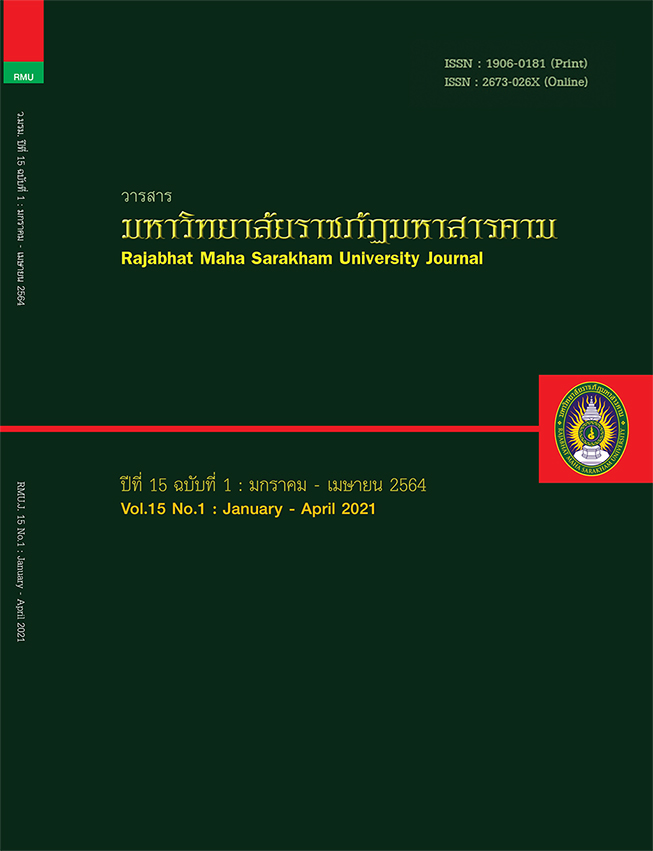ผู้ปกครองกับสื่อสร้างสรรค์เสริมสร้างทักษะสมอง EF
Main Article Content
บทคัดย่อ
บทความนี้มีวัตถุประสงค์เพื่อนำเสนอแนวคิดเกี่ยวกับการใช้สื่อในการพัฒนาทักษะสมอง EF ของเด็กปฐมวัย เนื่องจากเด็กในวัย 0-6 ปี เรียนรู้ผ่านการลงมือปฏิบัติ หรือที่เรียกว่า Active Learning เด็กจึงต้องการสื่อ และวัสดุอุปกรณ์ที่หลากหลาย เพียงพอ เหมาะสมกับวัย เพื่อสร้างโอกาสทางการเรียนรู้ และพัฒนาทักษะในด้านต่างๆ ทั้งการคิด วิเคราะห์ เสริมสร้างจินตนาการ ความคิดสร้างสรรค์จากการเล่น และฝึกทักษะการแก้ปัญหาด้วยตนเอง รวมไปถึงทักษะสมอง EF อันเป็นพื้นฐานสำคัญในการพัฒนาเด็กทั้งทางจิตและปัญญา ซึ่งในการพัฒนาทักษะ EF ทั้ง 9 ด้านนี้ผู้ใหญ่มีบทบาทสำคัญในการส่งเสริมทักษะ EF ให้แก่เด็กปฐมวัยได้ในทุกๆ ด้าน โดยการเลือกสื่อให้เหมาะสม สอดคล้องกับหลักการพัฒนาทักษะ EF เพื่อพัฒนาเด็กเติบโตและพัฒนาไปตามวัย
Article Details

อนุญาตภายใต้เงื่อนไข Creative Commons Attribution-NonCommercial-NoDerivatives 4.0 International License.
1. บทความที่ลงตีพิมพ์ทุกเรื่องได้รับการตรวจทางวิชาการโดยผู้ประเมินอิสระ ผู้ทรงคุณวุฒิ (Peer Review) สาขาที่เกี่ยวข้อง อย่างน้อย 3 ท่าน ในรูปแบบ Double blind review
2. ข้อคิดเห็นใด ๆ ของบทความที่ลงตีพิมพ์ในวารสารมหาวิทยาลัยราชภัฏมหาสารคาม นี้เป็นของผู้เขียน คณะผู้จัดทำวารสารไม่จำเป็นต้องเห็นด้วย
3. กองบรรณาธิการวารสารมหาวิทยาลัยราชภัฏมหาสารคาม ไม่สงวนสิทธิ์การคัดลอกแต่ให้อ้างอิงแสดงที่มา
เอกสารอ้างอิง
กุลยา ตันติผลาชีวะ. (2551). การจัดกิจกรรมการเรียนรู้สําหรับเด็กปฐมวัย. กรุงเทพฯ:เบรน-เบส บุ๊คส์
เตวิชวรจารุวรรณ. (2561). สื่อกับเด็กปฐมวัย.สืบค้นจาก https://sites.google.com/site/janetewit/home/sux-kab-dek-pthmway .
วรนาท รักสกุลไทย, และคณะ. (2561). การพัฒนาทักษะสมอง EF ด้วยการ “ให้โอกาส”. ใน สุภาวดี หาญเมธี, และคณะ. คู่มือพัฒนาทักษะสมอง EF Executive Function สำหรับครูปฐมวัย. กรุงเทพฯ: เอกพิมพ์ไทย.
สมจิต จันทร์ฉาย. (2557). การออกแบบและพัฒนาการเรียนการสอน. นครปฐม: เพชรเกษมพริ้นติ้ง กรุ๊ป จำกัด.
Center on the Developing Child. (2015). Activities Guide: Enhancing and Practicing Executive
Function Skills with Children from Infancy to Adolescence. Retrieve from https://developingchild.harvard.edu.
Dawson, P., &Guare, R. (2014).Interventions to promote executive development in children and adolescents. In Handbook of executive functioning.Springer, NY.
Diamond. (2013). Executive Functions. University of British Columbia and BC Children's Hospital. Canada
Earl K. Miller and Jonathan D. Cohen.(2001). AN INTEGRATIVE THEORY OF PREFRONTALCORTEX FUNCTION.Annual Review of Neuroscience.
Lisa B Thorell, Sofia Lindqvist, et al. (2009). Training and transfer effects of executive functions in preschool children. Stockholm: Sweden.
Miller and Cohen. (2014). The “working” of working memory. Massachusetts Institute of Technology, USA.
Newby, et al.(1999).Comparison of the short-term effects of candoxatril, an orally active neutralendopeptidase inhibitor, and frusemide in the treatment of patients with chronic heart failure. NCBINational Center for Biotechnology.
Russell A. Barkley. (2011). The Important Role of Executive Functioning and Self-Regulation in ADHD©. American
Seana Moran & Howard Gardner. (2012).Hill, Skill, and Will: Executive Function from Multiple- Intelligences Perspective, Executive Function in Education. From Theoryto Practice, edited by Lynn Meltzer, The Guilford Press,N.Y.


